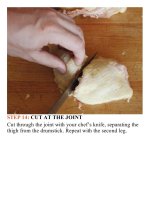The food lab better home cooking through science ( PDFDrive ) 1081
Bạn đang xem bản rút gọn của tài liệu. Xem và tải ngay bản đầy đủ của tài liệu tại đây (178.01 KB, 2 trang )
dipped in buttermilk and tossed in flour seasoned with salt
and black pepper, then fried in peanut oil at 325°F until
cookedthrough.Afewproblemsimmediatelybecameclear.
First off, timing: By the time my chicken was cooked
through(that’s150°Finthebreastsand165°Finthelegs§),
the outer crust was a dark brown, bordering on black in
spots. Not only that, but it didn’t have nearly as much
crunch as I wanted. Finally, the meat underneath the crust
wasn’t completely desiccated, but I wouldn’t exactly
describeitasmoist,nottomentionitsratherblandflavor.I
decidedtofixmychickenfromtheinsideout.
The problem is that with fried chicken, the crisp wellseasonedcoatingismerelyasurfacetreatment.Noneofthat
flavor penetrates very deeply. Surely brining and/or
marinating should help with that problem? Brining is the
process by which a lean meat (most often chicken, turkey,
or pork) is submerged in a saltwater solution.As the meat
sits,thesaltwaterwillslowlydissolvekeymuscleproteins—
most notably myosin, a protein that acts as a sort of glue,
holding muscle fibers together). As the myosin dissolves,
threethingstakeplace:
Lookscrispoutside,butinsidethischickenisdry.
• First, the ability of the meat to hold onto moisture
increases. You can imagine meat as a series of long,
skinny toothpaste tubes tied together. As you cook the
meat, the tubes of toothpaste get squeezed, pushing out
valuablejuices.Breadingwillhelpmitigatethiseffecttoa
degree by slowing down the transfer of energy to the
meat, but a significant amount of squeezing is still going
to occur regardless of how well breaded the chicken is.
Myosin is one of the key proteins responsible for this
squeezingaction,sobydissolvingit,youpreventalotof
moisturelossfromtakingplace.
• Second, brining alters the texture of the meat by









